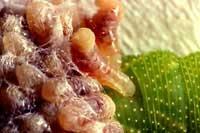Nature is curious!
Caterpillars, of course, have invented a defensive mechanism to combat wasps and have specialized blood cells that generate an asphyxiating capsule around the strange larva. But the wasps of the Braconidae family have also invented the way to overcome it. And for this purpose they have used viruses.

Polydnabiruses are viruses integrated into the chromosomes of parasitic wasps that spend most of the time asleep. But not always. In the 1990s, researchers at the University of Illinois found that in the eggs of the females these viruses are activated, freeing themselves from the DNA of the wasp and sticking outside the eggs. Then, by introducing the egg into the caterpillar, viruses secrete proteins that break the caterpillar defense system. Some of these proteins are wasp poison, so the researchers concluded that at some point in the evolution some of the wasp genes were transferred to viruses.
Now, analyzing the old wasps trapped in amber, it has been possible to verify that the symbiosis of virus and wasps began long ago. Researchers at the University of Illinois have estimated that Braconidae family virus wasps evolved between 93 and 45 million years ago. Three genes from 28 wasp species have been investigated to make a family tree of wasps with and without viruses and this information has been compared with the age of known fossils. Thus, they have concluded that the symbiosis between wasps and viruses mentioned in the article began 74 million years ago.
Buletina
Bidali zure helbide elektronikoa eta jaso asteroko buletina zure sarrera-ontzian











